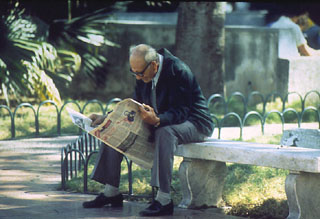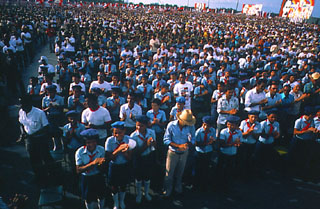 The islands that form Cuba together are nearly as large as the state of Pennsylvania
in the United States. There are low hills and fertile valleys over more than half of
the country. Three mountain ranges divide the country into three regions: west,
center, and east. There is a great contrast between the regions. The western side of
the country is made up of tropical forests. The central region consists of prairies,
and the east is mostly hills.
The islands that form Cuba together are nearly as large as the state of Pennsylvania
in the United States. There are low hills and fertile valleys over more than half of
the country. Three mountain ranges divide the country into three regions: west,
center, and east. There is a great contrast between the regions. The western side of
the country is made up of tropical forests. The central region consists of prairies,
and the east is mostly hills.
The average temperature is about 75° F with the climate being warm and humid. Rain and hurricanes are frequent from May to October.
The capital city of Havana was founded in the early 1500's, and was the capital and
gathering point for treasury fleets during the Spanish colonial period.
Government and Economy
Cuba is a socialist state, and the Communist Party is the leading force in the
society. There are 14 provinces and one municipality called the Isla de la
Juventud (Isle of Youth). There is also a National Assembly of People's Power
that has 589 deputies that are elected to serve in five-year terms. The chief of
state and president is Fidel Castro, a position he has held since the Cuban Revolution
of 1959.
Cuba's economy, up until the early 1990's, depended greatly on trade with Soviet bloc countries. When these trade relations broke down, the government responded by opening free markets for crafts and produce, and released some state-owned land to farming cooperatives. They also promoted self-employment and reorganized many state companies. They also have established joint ventures with foreign companies to increase tourism, mining, and construction. México and Canada are Cuba's most important trading partners.
Agriculture is an important part of the economy. The main crops are sugarcane, tobacco, citrus fruit, coffee, rice, and vegetables. Tourism is the second largest industry.
The official currency in Cuba is the peso, but the U.S. dollar is also legal, though the United States prohibits sending dollars to Cuba.
Language and People
 Spanish is the official language in Cuba, though the Cubans do speak with a different
accent, and this accent may differ in the different regions. Some examples of
different words in Cuba include amarillo, which is yellow everywhere else,
means traffic official; another is rebambaramba, which means a free-for-all.
Spanish is the official language in Cuba, though the Cubans do speak with a different
accent, and this accent may differ in the different regions. Some examples of
different words in Cuba include amarillo, which is yellow everywhere else,
means traffic official; another is rebambaramba, which means a free-for-all.
There are about 10.9 million people in Cuba, 2.2 million live in the capital of
Havana. The majority of the Cubans are of Spanish descent, the other majority is of
Black African descent. During the colonial period, they were brought in as slaves to
work in the sugarcane fields.
Greetings
Men greet each other with a handshake and a ¿Qué tal? (How are
you?). The general greetings of ¡Buenos días!, ¡Buenas
tardes! and ¡Buenas noches! are commonly used. Remember that if you
are meeting someone for the first time to use the formal usted form of the
Spanish verbs to show respect. The titles of Señor (Mr.),
Señora (Mrs.), and Señorita (Miss) are also used.
Other common greetings include Compañero/Compañera (comrade). Nicknames are also common among friends.
Common phrases used to say good-bye include Hasta luego (Until later), Nos vemos (We'll see you), and Chao (Good-bye).
Food
The Cuban diet is based on foods grown locally like arroz y frijoles (rice and
beans), which is a traditional staple meal. Other typical foods include
boniatos (sweet potatoes), yuca (cassava), plátanos
(plantains), and tomatoes.
Roast pork is a favorite food, but considered a luxury. Seafood is eaten in the coastal areas. Fruits are also very popular and include mangoes, avocados, guavas, oranges, lemons, and pineapple.
Here is a recipe for:
Rice Salad
(Ensalada de Arroz)Ingredients:
Directions:
2 cups cold cooked rice 1 tart green apple 1/2 avocado, peeled and sliced 1 cup canned peas, drained 1 tablespoon chopped pimento 1 tablespoon lemon juice 1 tablespoon vinegar 2 tablespoons olive oil 1 teaspoon prepared mustard Salt and pepper, to taste Lettuce Garnish: Cooked beets, shrimp, or hard-cooked eggs
Mix the rice with fruits and vegetables. Make dressing of lemon juice, vinegar, oil, and mustard; then add it to the rice mixture. Season to taste. Refrigerate mixture for at least 30 minutes.Arrange rice in a pyramid on a bed of shredded lettuce, or press into a mold and then unmold. Garnish with cooked beets, shrimp, or eggs. Serve with your favorite salad dressing.
Cubans enjoy music and dancing. The rumba, mambo, and cha-cha-cha all originated in Cuba.
Important holidays include Liberation Day (January 1), and Mother's Day (the second Sunday in May). Religious holidays are not officially recognized, but many are celebrated with feasts and religious services.
For more information on Cuba, please visit:
Photos courtesy of the UN